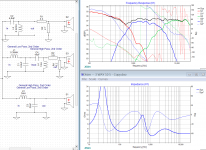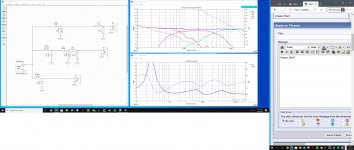Begin by ditching the phase trace for the system, and adding it for at least two of the drivers at a time. The first thing you can try is getting the response slopes similar. Phase has a tendency to fall into place, but you want to watch that it does.
1. Still not happy with the impedance but it's a step in the right direction.
2. Here, obviously I haven't worked on the lower cross.
1. Still not happy with the impedance but it's a step in the right direction.
2. Here, obviously I haven't worked on the lower cross.
Attachments
Nice simulation. Impedance now looks good. I did not follow if the frd and zma files are based on your measurements, or are they factory curves?
This is all factory curves. My plan was to get as good as i can with the factory curve and getting them as good as i can but still simple so im not spending 150 dollars on crossover parts just to get it all together and end up swapping them out. So i think my next step is ordering the mids and the co parts and that should be good for now, later on ill invest in a mic and some testing equipment and go from there. Is this all good enough to go ahead and purchase the parts? Again thank you everyone.
Your sim looks fairly good now but the overall sensitivity suggests that you have not included baffle diffraction effects. That means it will not end up sounding right.
Jeff Bagby's Response Modeler will get that done for you. Although you do need Excel.
I might also try dropping the resonance peak of the woofer just a little more. Try a 1uF cap in parallel with L1, notice the effect and then adjust it up or down from there.
Just fyi - besides L-pads, a series resistor by itself either before or after the main filter will also attenuate a driver. There will be subtle differences in the FR which can sometimes be helpful (or sometimes not) and not so subtle differences to the impedance. The choice of what to use is situational.
Jeff Bagby's Response Modeler will get that done for you. Although you do need Excel.
I might also try dropping the resonance peak of the woofer just a little more. Try a 1uF cap in parallel with L1, notice the effect and then adjust it up or down from there.
Just fyi - besides L-pads, a series resistor by itself either before or after the main filter will also attenuate a driver. There will be subtle differences in the FR which can sometimes be helpful (or sometimes not) and not so subtle differences to the impedance. The choice of what to use is situational.
I believe you should hold off on ordering crossover parts for now.
The simulations you have done so far should be seen as feasibility studies: They show you that this particular set of drivers can be made to work well together. The crossover design in this simulation is one plausible design, but it is unlikely to be the exact crossover you end up with.
Your next steps should be
(0) read this thread So you want to design your own speaker from scratch!
(1) order the drivers and get them. You need the drivers before you start making your cabinets.
(2) build your enclosure. If you are feeling sporty, you can build the final enclosure (I would), but some people like to build a prototype first. XPS foam sheet is a good material for making a prototype cabinet.
(3) make frequency response measurements of your drivers in your cabinet.
(4) use the FRD files from your measurements to simulate a new crossover. Start with your existing one, but don't be surprised if it needs quite a bit of tweaking.
(5) order the crossover parts.
There are actually more steps involved. Wintermute's excellent thread goes through the details. I did not mention measuring the impedance of your drivers, which ideally you should do. I also did not discuss measuring the T/S parameters of your woofer, which again you should ideally do.
The simulations you have done so far should be seen as feasibility studies: They show you that this particular set of drivers can be made to work well together. The crossover design in this simulation is one plausible design, but it is unlikely to be the exact crossover you end up with.
Your next steps should be
(0) read this thread So you want to design your own speaker from scratch!
(1) order the drivers and get them. You need the drivers before you start making your cabinets.
(2) build your enclosure. If you are feeling sporty, you can build the final enclosure (I would), but some people like to build a prototype first. XPS foam sheet is a good material for making a prototype cabinet.
(3) make frequency response measurements of your drivers in your cabinet.
(4) use the FRD files from your measurements to simulate a new crossover. Start with your existing one, but don't be surprised if it needs quite a bit of tweaking.
(5) order the crossover parts.
There are actually more steps involved. Wintermute's excellent thread goes through the details. I did not mention measuring the impedance of your drivers, which ideally you should do. I also did not discuss measuring the T/S parameters of your woofer, which again you should ideally do.
I'm not going to disagree with anything hifijim has said above but I am going to offer 1 more alternative.
If you are using drivers that are known for accurate spec sheet measurements, for eg. Dayton, and if you have done the sims to accurately represent the drivers in the speaker cabinet, then after step #2 above try out the xo you have simmed. If it sounds good to your ears and your listening preferences then you are done. If not, you may be able to tweek it a little to improve it. If you are still not happy, then go ahead with step 3 and beyond from above.
It's just I think that we forget sometimes that not everybody is a serious listener or requires a speaker that is up to our own high standards. Different people have different expectations and different listening habits. Or in other words, not every speaker has to be perfect to be enjoyable.
Just a thought anyways.
If you are using drivers that are known for accurate spec sheet measurements, for eg. Dayton, and if you have done the sims to accurately represent the drivers in the speaker cabinet, then after step #2 above try out the xo you have simmed. If it sounds good to your ears and your listening preferences then you are done. If not, you may be able to tweek it a little to improve it. If you are still not happy, then go ahead with step 3 and beyond from above.
It's just I think that we forget sometimes that not everybody is a serious listener or requires a speaker that is up to our own high standards. Different people have different expectations and different listening habits. Or in other words, not every speaker has to be perfect to be enjoyable.
Just a thought anyways.
very true jReave. If xHavoc goes straight to building a crossover, he should buy a collection of resistors for trimming his filters. You can do a lot of tweaking with resistors.
Thank you guys very much, i appreciate everyone for taking time and giving me their input. I ordered all the parts last night at about 3am, had to make a few tweaks to either save some cash or the cap or coil landed on a number that isnt available so i had to bump them up or down one. The ohms landed in a slightly better spot i think. I know doing it in xsim with factory files probably isnt going to be perfect, and i havnt done anything for baffle yet (other than keeping the woofer db higher). So im going to get it all together and give it a listen. If im not satisfied ill probably have to wait a few weeks or months depending on my schedule, but then ill get a mic and program to test it properly and design a new crossover. Ill come back here after i get everything half way put together and let you all know how it sounds. Cant be worse than what i got now!
A design without baffle diffraction included is going to sound like it lacks bass and perhaps be a little chesty because of the couple of dB hump centered around about 500-600Hz for the baffle width you are probably using.
Your best bet is to put them right up against a wall or put it into something like a bookshelf where it is totally surrounded by some king of solid surfaces. You know, like books.
Your best bet is to put them right up against a wall or put it into something like a bookshelf where it is totally surrounded by some king of solid surfaces. You know, like books.
- Home
- Loudspeakers
- Multi-Way
- DIY Help - 2

